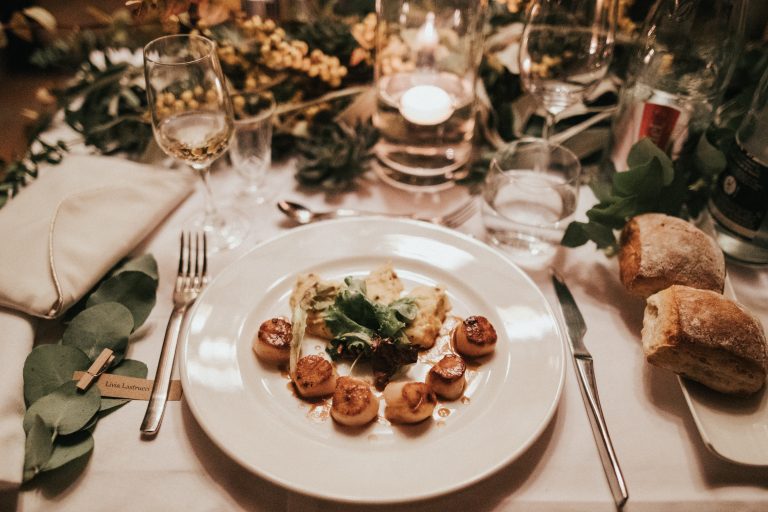[fbshare type=”button” float=”right” width=”100″] By Emily Stimpson Chapman

If you’re searching the Church calendar for the greatest feasts and greatest fasts, you’ll usually find them cozied up next to each other, with the fasts preparing us for the feasts to come, and the feasts helping us better understand the fasts just passed (see CCC 2043). In the balance, though, Christians who plan their meals according to the liturgical calendar will find themselves doing a great deal more feasting than fasting.
In the Catholic Church, every season of fasting is followed by a longer season of feasting. Lent is forty days. Easter is fifty. Advent lasts a little over four weeks. Christmas lasts a solid five and half weeks, beginning on December 25 and running right up to February 2, the Feast of the Presentation.
Moreover, while the Latin Church mandates two days of fasting (Ash Wednesday and Good Friday) plus another forty-eight or so days of abstinence (most other Fridays throughout the year), her calendar provides about three times as many opportunities for feasting.
We feast on Christmas Day and Easter Day, Holy Days of Obligation, Solemnities, and every single Sunday, all of which the Church considers “little Easters.” We also can choose to celebrate favorite saints and martyrs on the dozens and dozens of days set aside to remember them. Heck, we can even feast in honor of buildings. The papal basilica of St. John Lateran and the Portiuncula chapel rebuilt by St. Francis both have feasts of their own (November 9 and August 2, respectively).
In the Catholic Church, we always have cause for feasting. Which is grand for someone who likes hosting parties as much as I do. But the ultimate cause for our feasting is never a saint or a stunning work of architecture. The ultimate cause is always Christ.
Feasting, like fasting, is an eminently human activity. The Greeks, the Romans, the blue-painted Picts, and just about every other grouping of men and women since Adam and Eve have set aside days for indulging in the best that creation has to offer.
Many of those feasts have been religious in nature; people feasted to honor the gods (or God) in which they believed. Other feasts were celebratory; they commemorated victories in battle, triumphs over disease, or the survival of particularly harsh winters. And even more feasts took place simply for the host to impress his friends, enemies, and neighbors. Some feasts were thrown for a combination of all three reasons.
Jesus’ disciples fasted after he ascended to heaven. The Book of Acts and other early records of the Apostles’ ministry, such as the Didache, attest to that. But his disciples also feasted, gathering together on Sundays for the Eucharist and for a common meal (often referred to as the agape meal or “love feast”). The first Christians did these things not in contradiction to Jesus’ words in Luke 5:34–35, but rather in obedience to them.
Christ, after all, is the Bridegroom. His people, the Church, are the Bride. Union with him is our hope and goal. It’s our destiny . . . if we don’t forsake it for sin.
That destiny is described by Isaiah as a banquet, where God will “make for all peoples a feast of fat things, a feast of choice wines—of fat things full of marrow, of choice wines well refined” (Is 25:6).
The Psalmist also speaks of God’s children feasting “on the abundance of [his] house” and drinking “from the river of [his] delights” (Ps 36:8), while Jesus himself compares the kingdom of heaven to “a marriage feast” thrown by a king for his son (Mt 22:2).
Later, the Book of Revelation tells us that the end of salvation history is a wedding banquet. The angels issue a call—“Come, gather for the great supper of God” (Rev 19:17). They also promise blessing to all who answer the call—“Blessed are those who are invited to the marriage supper of the Lamb” (19:9).
This is how God wants us to see heaven: as the people of God, feasting without restraint on his presence, drinking in the Trinity’s beauty, goodness, truth, and love to the point of holy intoxication.
Fasting teaches us about our hunger, our dependency, our need for Christ. Feasting, understood in the light of faith, teaches us about answered prayers, about a God who fills our emptiness and satisfies our hunger beyond our greatest imaginings. It foreshadows the great feast yet to come, whetting the appetite of all who partake in it for the marriage supper of the Lamb.
That’s why Christ’s first followers feasted. They feasted in anticipation of that ultimate feast. And that’s why Christians continue to feast.
No matter how grand or humble, every Christian feast is a foreshadowing—or more accurately, a foretaste—of the heavenly wedding feast. For even though we can’t look on Christ face to face just yet, he is with us. He is present in his Church. He is present in the Eucharist. And where he is present, we feast.
Emily Stimpson Chapman is the award-winning author of several books, including The Catholic Table: Finding Joy Where Food and Faith Meet. Learn more about how the sacramental worldview gives deeper meaning to everyday life, including food and hospitality, in this bright and engaging look at food and faith.